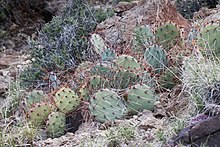|
Opuntia phaeacantha
Opuntia phaeacantha is a species of prickly pear cactus known by the common names brown-spine prickly pear, tulip prickly pear, and desert prickly pear found across the southwestern United States, lower Great Plains, and northern Mexico. The plant forms dense but localized thickets. Several varieties of this particular species occur, and it may hybridize with other prickly pears, making identification sometimes tricky. DescriptionOpuntia phaeacantha has a mounding habit of flattened green pads. The pads are protected by clusters of spines. Each cluster bearing 1-4 spines. The spines are brown, reddish-brown, yellowish, or gray, usually darker brownish toward the base than the tip, and often over 3 cm in length. At the base of the spine cluster is a round tuft of easily detached yellowish to reddish or brown bristles called Glochids. Glochids are also present on the fruit. This is the source for the plants common name "prickly pear". The flowers are bright yellow with a pale green to orange or red center. In some regions occasional plants may produce flowers of other colors such as orange, pink, or magenta. The edible fruits are usually red or purple with a pink seedy flesh. The fruit has a mild watermelon or pear flavor. Both the fruit and the fleshy pads provide an important food resource for desert wildlife.
This plant, like other Opuntia species, is attacked by cactus moth. Other common names for this species, and ones which are now considered variants of this species, include plateau prickly-pear, New Mexico prickly-pear, and Kingman prickly-pear. The species is widespread, from California south to Mexico and the Southwest United States. There are multiple variations and perhaps these will be described as varieties or full species some day.[3] UsesThe cactus can be prepared as food in a similar fashion to Opuntia humifusa.[4] References
External linksWikimedia Commons has media related to Opuntia phaeacantha. |
||||||||||||||||||||||||||||||||||





